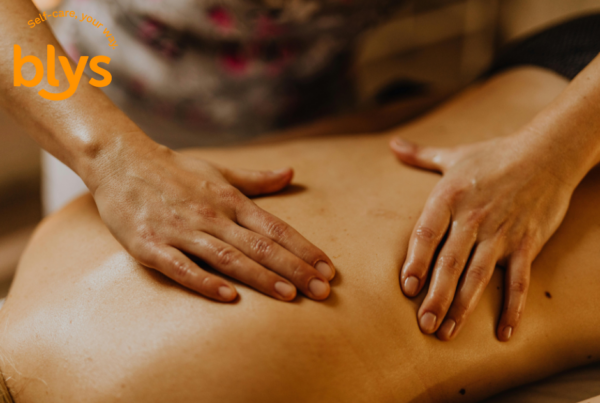What is sciatica?
Sciatica is the term used to refer to pain along the sciatic nerve. Sciatica pain occurs when nerve roots that make up the sciatic nerve become pinched or compressed. It starts in the lower back, follows through the hips and buttocks, and down the legs along the sciatic nerve pathway. Approximately 40% of people will experience a sciatic episode in their lifetime. Typically, it affects only one side of your body and can range from mild to severe. It may be accompanied by numbness, tingling or weakness in the affected leg and foot.
Sciatica can interfere with your daily activities and make standing, walking, and even sitting difficult.

Sciatica can be acute or chronic.
- Acute: These episodes may last between one and two weeks, and you may experience some numbness for a while after the pain has subsided. These may occur a handful of times a year.
- Chronic: Chronic sciatica is a life-long condition. It doesn’t currently respond well to treatment, but the pain from chronic sciatica is often less severe than the acute form.
What can cause sciatica?
Three of the most common risk factors for sciatica include your occupation, prolonged sitting (and these two are commonly related), and age.
- Occupation: Certain careers place a lot of strain on your back, especially those that involve lifting heavy objects, sitting for extended periods, or twisting movements.
- Prolonged sitting: People who sit for prolonged periods or have a sedentary lifestyle are more likely to develop sciatica than active people are.
- Age: Age-related changes in the spine, such as herniated disks and bone spurs, are among the most common causes of sciatica.

The two main causes of sciatic nerve pain are:
- A bulging disc or herniated disc: This occurs in the lumbar part of the spine when the soft jelly interior of a disc pushes out through a tear in an exterior disc.
- Piriformis syndrome: The most common cause of sciatic nerve pain. The piriformis is a triangular shaped muscle running under the glutes. Piriformis syndrome is caused by muscle spasm or tightness in the piriformis muscle which compresses the sciatic nerve. In most cases, the sciatic nerve runs directly under the piriformis. However, in about 17% of people the sciatic nerve goes straight through the piriformis muscle, causing greater susceptibility to sciatic nerve pain.
How to test for a herniated disc or piriformis syndrome
Testing for herniated disc:
-
- Keeping a straight back, bend forward at the waist and then bend backwards. Is there pain? Does any movement of the back tend to make it worse? If so, this pain may be caused by a bulging or herniated disc. It is important to see your doctor so that they can diagnose this accurately and recommend the best treatment.
Testing for piriformis syndrome:
-
- Is the piriformis very tender to the touch? This may be a sign of piriformis syndrome.
- Sitting down with a straight back, bring the ankle of the affected side up to rest on the opposite knee. Gently pull the knee of the affected side towards the opposite shoulder until you can feel the stretch. Repeat on the non-affected side to feel the difference.
- Lay on table face down with one leg draping over side of table. Bend knee and place foot at opposite straight knee (laying down tree pose), raise hanging knee up and down tightening the piriformis.
Massage and sciatica
Massage therapy helps alleviate sciatic nerve pain in several ways:
- Tight lower back muscles can place stress on your nerve roots. Massage therapy loosens these muscles and helps prevent pinching or irritation.
- A massage encourages the release of pain-fighting endorphins which can provide temporary relief from symptoms like the throbbing pain in your foot or the burning sensation in your leg.
- Massage promotes blood circulation which will ease sciatic nerve tenderness and built up tension.
Massage for sciatica won’t cure the underlying cause of your pain, but it can help to relieve your symptoms and improve your quality of life. Speak to your doctor about your symptoms before starting massage therapy to make sure it’s safe for you.

While it may seem like exercise will only make the problem worse, in fact the Mayo Clinic recommends low-impact exercise, like water aerobics or stationary bike riding, as a way of releasing the endorphins which act as natural painkillers. Another way of releasing those endorphins is massage.
Easy, at-home self-massages to help manage sciatic pain
Palm and Thumb Massage
- Place the palms of your hands on your lower back.
- Rub the pelvic area towards your spine and down towards your buttocks.
- Next, place your hands at your waist with your thumbs on the ropelike muscles near the spine. Wrap your fingers around your sides.
- Using your thumbs, apply a firm and steady pressure toward the spine on the outer edges of the ropey muscles, so that your thumbs are about four inches apart.
- Apply pressure without causing discomfort.
Tennis Ball Massage
- Put two tennis balls close together in a towel or sock.
- Sit down on the floor with your knees bent and feet flat on the floor. Place the balls behind you.
- Gradually recline your body until you are lying on your back on the floor, with the balls on the sore area of your back. Rest in this position if you can for one minute.
- When the back tension is relieved, move the balls to another area of your back.
- Slowly roll onto your side into a comfortable fetal position using your arm under your head (as a pillow).
- Rest in this position for five minutes before getting up.
Knuckle Pressure
- Lie on your back with your knees bent and your feet flat on the floor.
- Make fists and carefully place them on the left and right side of your lower back.
- Position your fists so your palms are facing down and your knuckles are against your back.
- Your fists should be between the spine and your lower back muscles.
- Rest in this position if you can for one minute.
- Slowly roll onto your side into a comfortable fetal position, using your arm under your head (as a pillow).
- Rest in this position for five minutes before getting up.
Suggestions for pain management between massages
Applying hot or cold packs to your lower back may provide temporary relief. Start by applying an ice pack to decrease sciatic nerve inflammation then follow up directly with a heating pad to soothe muscle tension and encourage blood flow to the tense muscles and nerves in the area at the backs of the legs and buttocks.

You can also try these six stretches to help relieve sciatic nerve pain.
Over-the-counter medication, like paracetamol or ibuprofen, may help reduce inflammation, swelling, and alleviate some of your pain.




